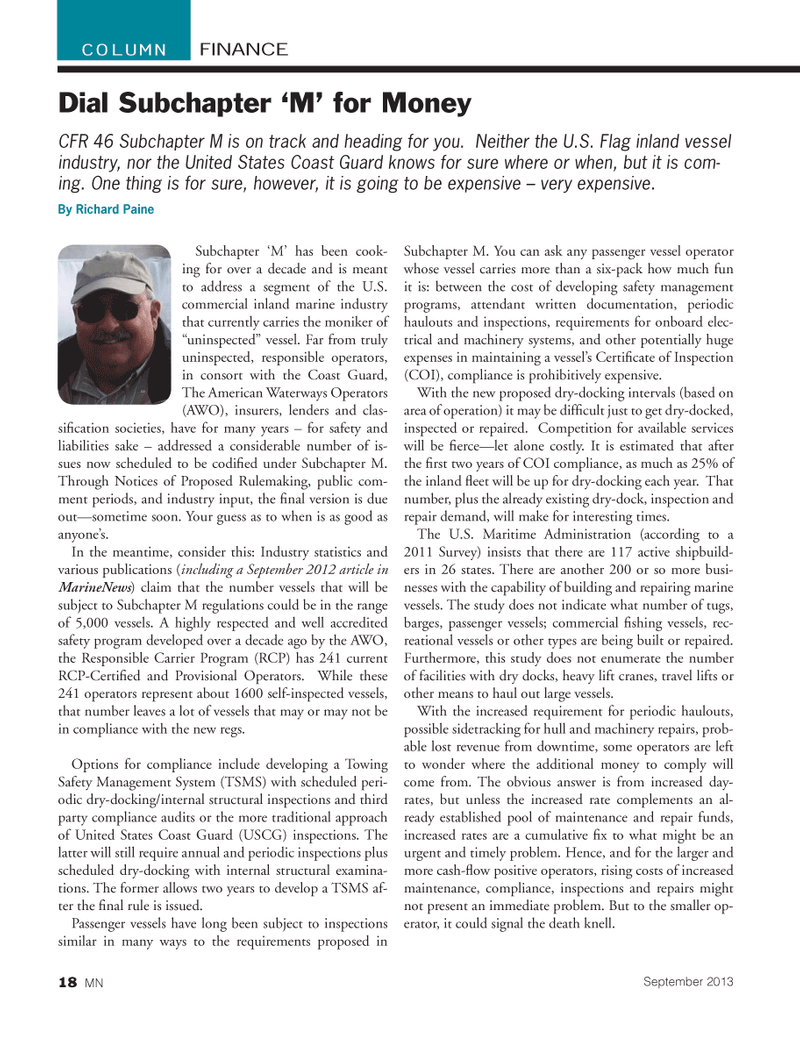
Page 18: of Marine News Magazine (September 2013)
Workboat Annual
Read this page in Pdf, Flash or Html5 edition of September 2013 Marine News Magazine
Subchapter M has been cook- ing for over a decade and is meant to address a segment of the U.S. commercial inland marine industry that currently carries the moniker of uninspected? vessel. Far from truly uninspected, responsible operators, in consort with the Coast Guard, The American Waterways Operators (AWO), insurers, lenders and clas- si? cation societies, have for many years ? for safety and liabilities sake ? addressed a considerable number of is- sues now scheduled to be codi? ed under Subchapter M. Through Notices of Proposed Rulemaking, public com- ment periods, and industry input, the ? nal version is due out?sometime soon. Your guess as to when is as good as anyones. In the meantime, consider this: Industry statistics and various publications ( including a September 2012 article in MarineNews ) claim that the number vessels that will be subject to Subchapter M regulations could be in the range of 5,000 vessels. A highly respected and well accredited safety program developed over a decade ago by the AWO, the Responsible Carrier Program (RCP) has 241 current RCP-Certi? ed and Provisional Operators. While these 241 operators represent about 1600 self-inspected vessels, that number leaves a lot of vessels that may or may not be in compliance with the new regs. Options for compliance include developing a Towing Safety Management System (TSMS) with scheduled peri- odic dry-docking/internal structural inspections and third party compliance audits or the more traditional approach of United States Coast Guard (USCG) inspections. The latter will still require annual and periodic inspections plus scheduled dry-docking with internal structural examina- tions. The former allows two years to develop a TSMS af- ter the ? nal rule is issued. Passenger vessels have long been subject to inspections similar in many ways to the requirements proposed in Subchapter M. You can ask any passenger vessel operator whose vessel carries more than a six-pack how much fun it is: between the cost of developing safety management programs, attendant written documentation, periodic haulouts and inspections, requirements for onboard elec- trical and machinery systems, and other potentially huge expenses in maintaining a vessels Certi? cate of Inspection (COI), compliance is prohibitively expensive. With the new proposed dry-docking intervals (based on area of operation) it may be dif? cult just to get dry-docked, inspected or repaired. Competition for available services will be ? erce?let alone costly. It is estimated that after the ? rst two years of COI compliance, as much as 25% of the inland ? eet will be up for dry-docking each year. That number, plus the already existing dry-dock, inspection and repair demand, will make for interesting times. The U.S. Maritime Administration (according to a 2011 Survey) insists that there are 117 active shipbuild- ers in 26 states. There are another 200 or so more busi- nesses with the capability of building and repairing marine vessels. The study does not indicate what number of tugs, barges, passenger vessels; commercial ? shing vessels, rec- reational vessels or other types are being built or repaired. Furthermore, this study does not enumerate the number of facilities with dry docks, heavy lift cranes, travel lifts or other means to haul out large vessels. With the increased requirement for periodic haulouts, possible sidetracking for hull and machinery repairs, prob- able lost revenue from downtime, some operators are left to wonder where the additional money to comply will come from. The obvious answer is from increased day- rates, but unless the increased rate complements an al- ready established pool of maintenance and repair funds, increased rates are a cumulative ? x to what might be an urgent and timely problem. Hence, and for the larger and more cash-? ow positive operators, rising costs of increased maintenance, compliance, inspections and repairs might not present an immediate problem. But to the smaller op- erator, it could signal the death knell. Dial Subchapter M for Money CFR 46 Subchapter M is on track and heading for you. Neither the U.S. Flag inland vessel industry, nor the United States Coast Guard knows for sure where or when, but it is com- ing. One thing is for sure, however, it is going to be expensive ? very expensive. By Richard Paine FINANCECOLUMN18 MNSeptember 2013MN Sept2013 Layout 18-31.indd 188/29/2013 11:11:56 AM

 17
17

 19
19
